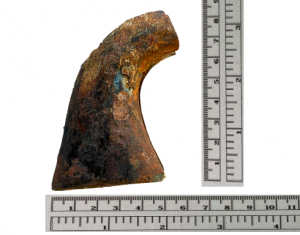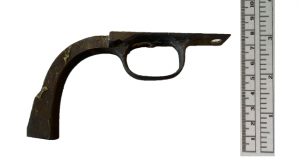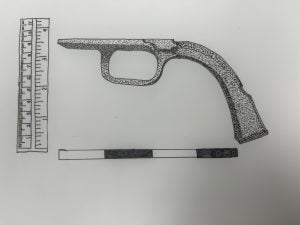Nevada
Colt M1860 Army .44 Cal. Pistol Trigger Guards and Ivory Grip Artifacts from the Steamship Nevada
Logan Willis
American Maritime Material Culture, Hist 6825
Historical Context
Approximately seven miles south of Cape Hatteras, lies a wooden-hulled vessel seventy- five feet below the oceans surface. Departing from New York, the Nevada was on its way to Vera Cruz, Mexico, via Havana, Cuba, with a load of general cargo.[1] Falling victim to Diamond Shoals like many before it, the steamer Nevada, became heavily pounded by large swells within a thick fog and ran aground. In an effort to save the vessel, the crew jettisoned much of the cargo but their failed and the steamer continued to steadily take on water. During daylight on June 4, 1868, it became necessary to abandon the Nevada. The steamer drifted south for two days before submerging into its final destination. Twenty crewmen and six passengers were loaded into lifeboats and all, but one sailor was reported to have made it safely to a nearby beach. New York Times reported on June 10, 1868 that the sailor had drowned during an attempt to get out an anchor.[2]
Nevada launched on September 5, 1864 and in its earliest years was owned by Wakeman, Gookin, and Dickerson of New York. The 160 ft. long steamer was built in Mystic, Connecticut by Maxon, Fish and Company, and during the Civil War was routinely charted by the federal government to transport troops and supplies.[1] Following the completion of the war, Nevada ran a commercial route of general cargo between Savannah, Georgia and New York.[2] The vessel was operated by the New York and Mexican Mail Steamship Line until it was sold in 1866 to Francis Alexander and Sons of New York on April 24, 1868.[3] A few months after this purchase was completed, Nevada found itself lying among the many abandoned vessels in the Graveyard of the Atlantic. Immediately following news of the sinking, Baker Salvage Company wrecking steamers Resolute and Winants dispatched from Norfolk, VA, in an effort to salvage the wreck. When the wreckers arrived on site, only the tops of the Nevada mast were visible. The steamer and its cargo were declared a total loss ranging between $200,000 and $800,000.
There is very little known about the steamer Nevada and information regarding the vessel is scarce. Perhaps this is due to the “general cargo”, the steamer was carrying to Cuba the day it grounded. October 1868 marked the beginning of the Ten Years War where Cuba sought its Independence from Spain following an economic depression from 1866 to 1867. The United States officially became involved in 1898 starting the Spanish-American War. Artifacts found by local divers at the sunken vessel helped identify the wreck but raised a number of questions. Material such as; small pewter spoons, a felt hat, shoes, silverware, china, light fixtures and portholes were discovered but it was the remaining engine configuration that positively identified the wreck as the Nevada, and the large number of war materials that makes this wreck so intriguing. A considerable number of rifles, pistols, musket flints, sabers, rounds, ammunition, and crates of rifles have been discovered in the thousands at this wreck. This can hardly be considered as general cargo. Could the Nevada have been in the middle of a smuggling act? At the time of Nevada’s loss, Cuban rebels were extremely active in New York and are said to have collected arms and ammunition for smuggling out to Long Island Sound for shipment to south Cuba and Vera Cruz, Mexico, which happened to be the center of support for the Cuban independence movement and the ultimate destination of the Nevada.
The steamer and cargo were insured by the Atlantic Mutual Insurance Company in Madison, New Jersey, and in addition to sending two wreckers to the Nevada on the day of its sinking, the company may have hired a diver in 1868 to investigate the wreck. Records concerning cargo on the Nevada exist; however, these records are sealed to this day and the war materials recovered at the wreck do not appear on any available manifest, raising many questions.
Description of collection
The majority of artifacts recovered from the steamer Nevada have been gifted to the Graveyard of the Atlantic Museum, Cape Hatteras, North Carolina, by local recreational scuba divers. It is there where curation and conservation continue for the material. Three items chosen for closer observation include two colt trigger pistol guards and an ivory grip. The left panel of the ivory grip is smooth, while the right panel clearly features an eagle tearing into a snake with its beak as it perches on a pear cactus. This engravement is a variant of the Seal of Mexico; however, the archivist stated that this escutcheon was not exclusive to Mexico and has no real significance.[1] The pistol guards are believed to be from a Colt M1860 Army.44 Caliber percussion revolver made in 1868; however, it is important to mention that the pistol guard with serial number 173365 is in better condition, noticeably larger, and will not fit with the ivory handle grip.




